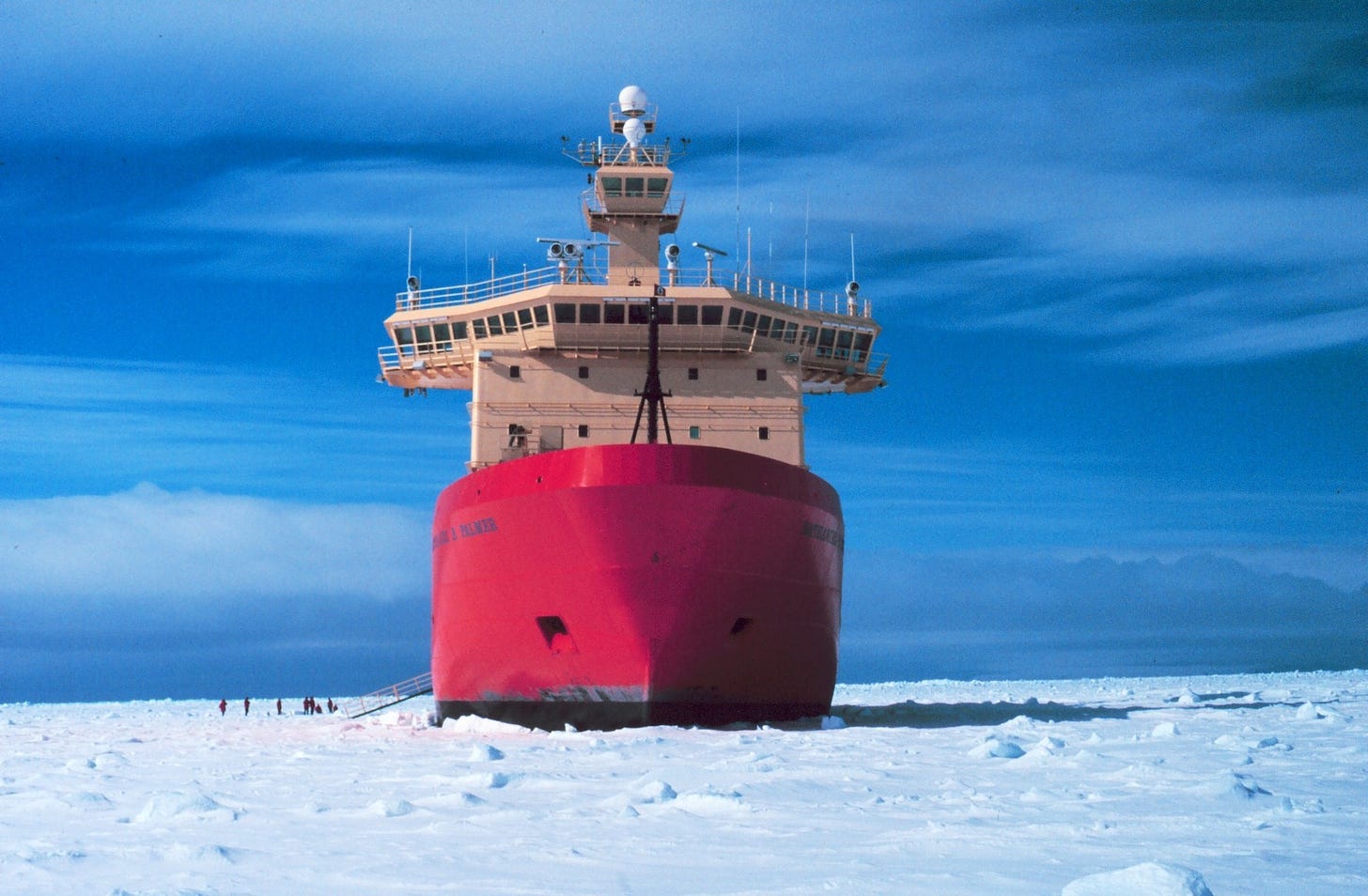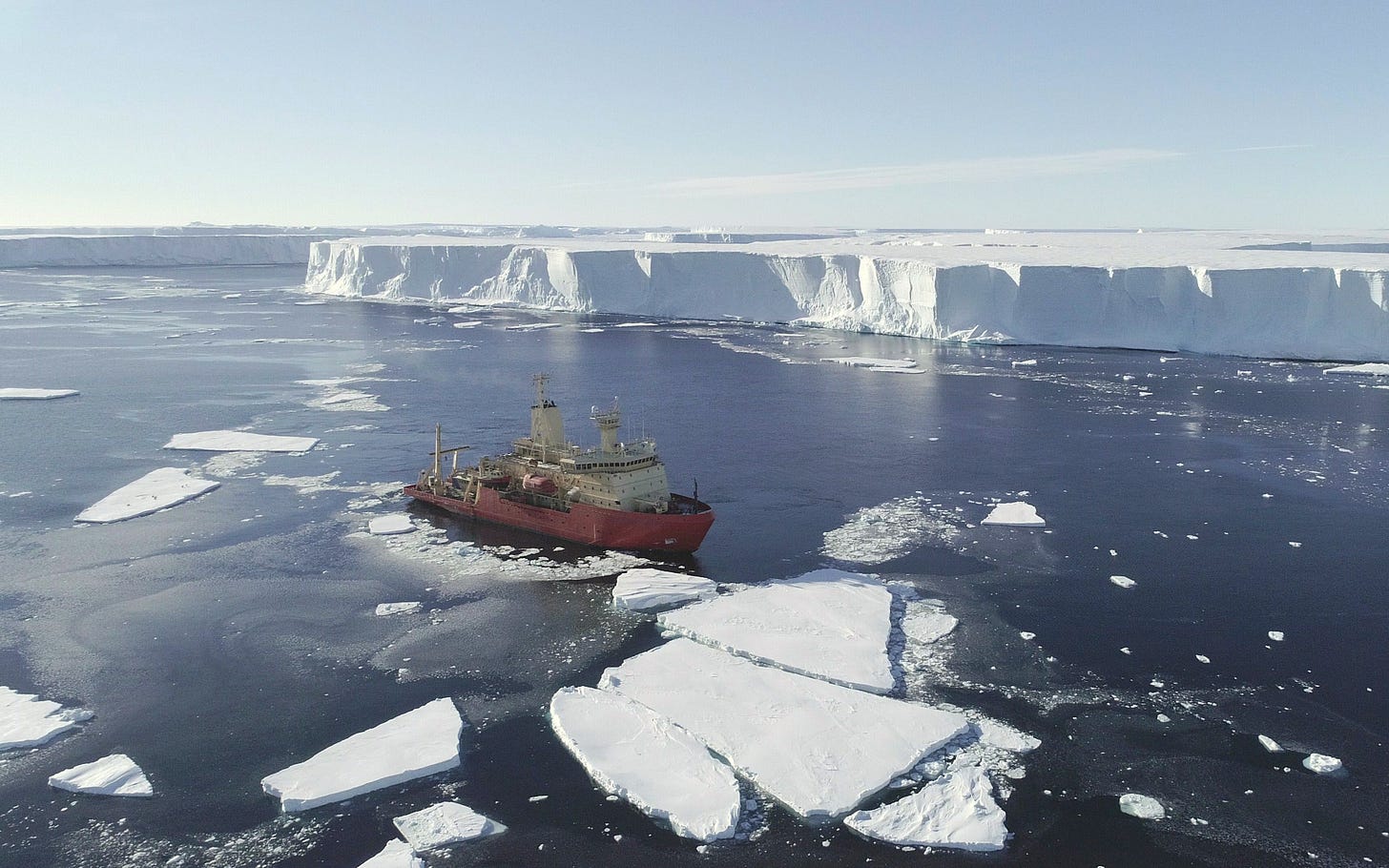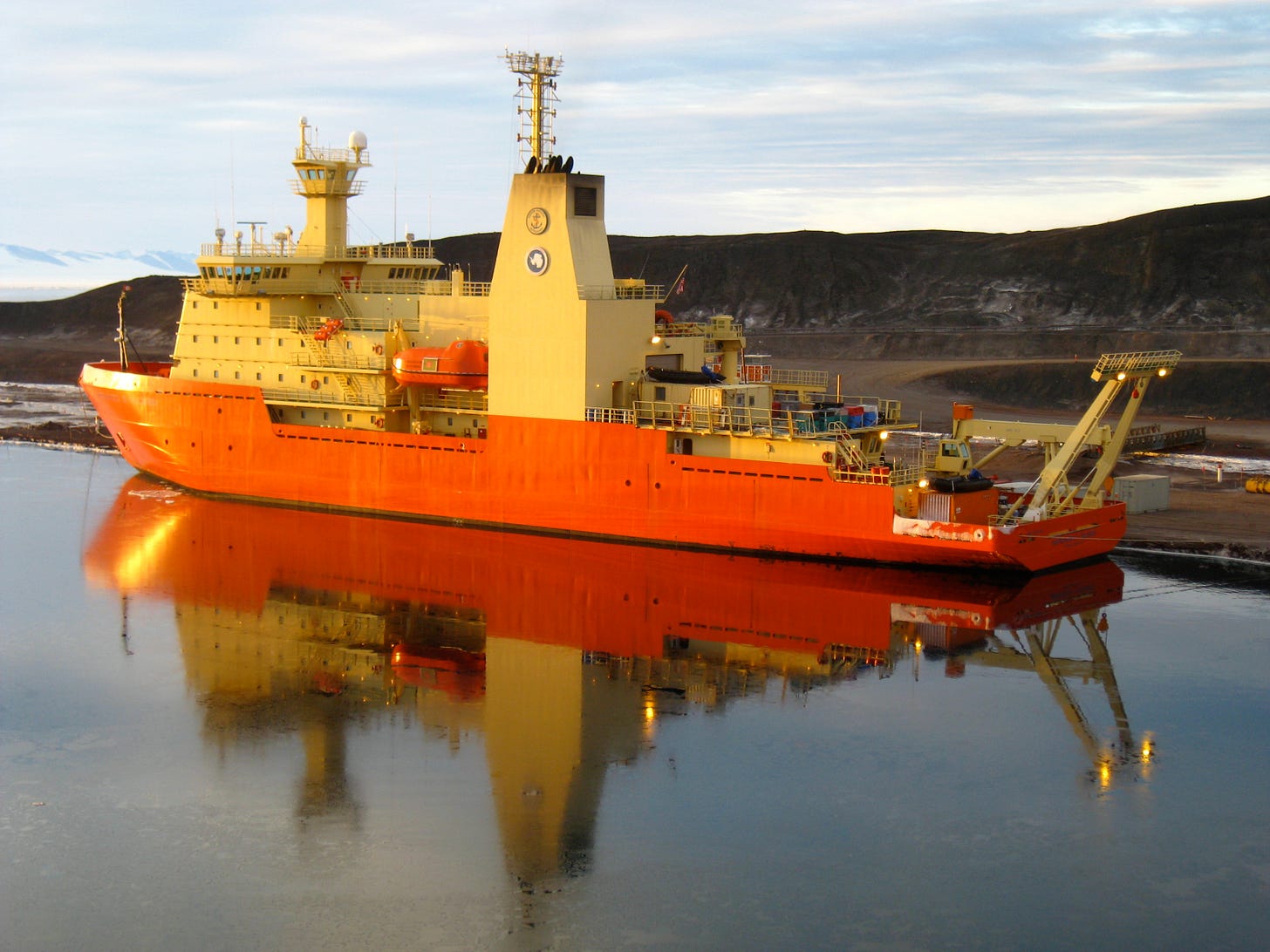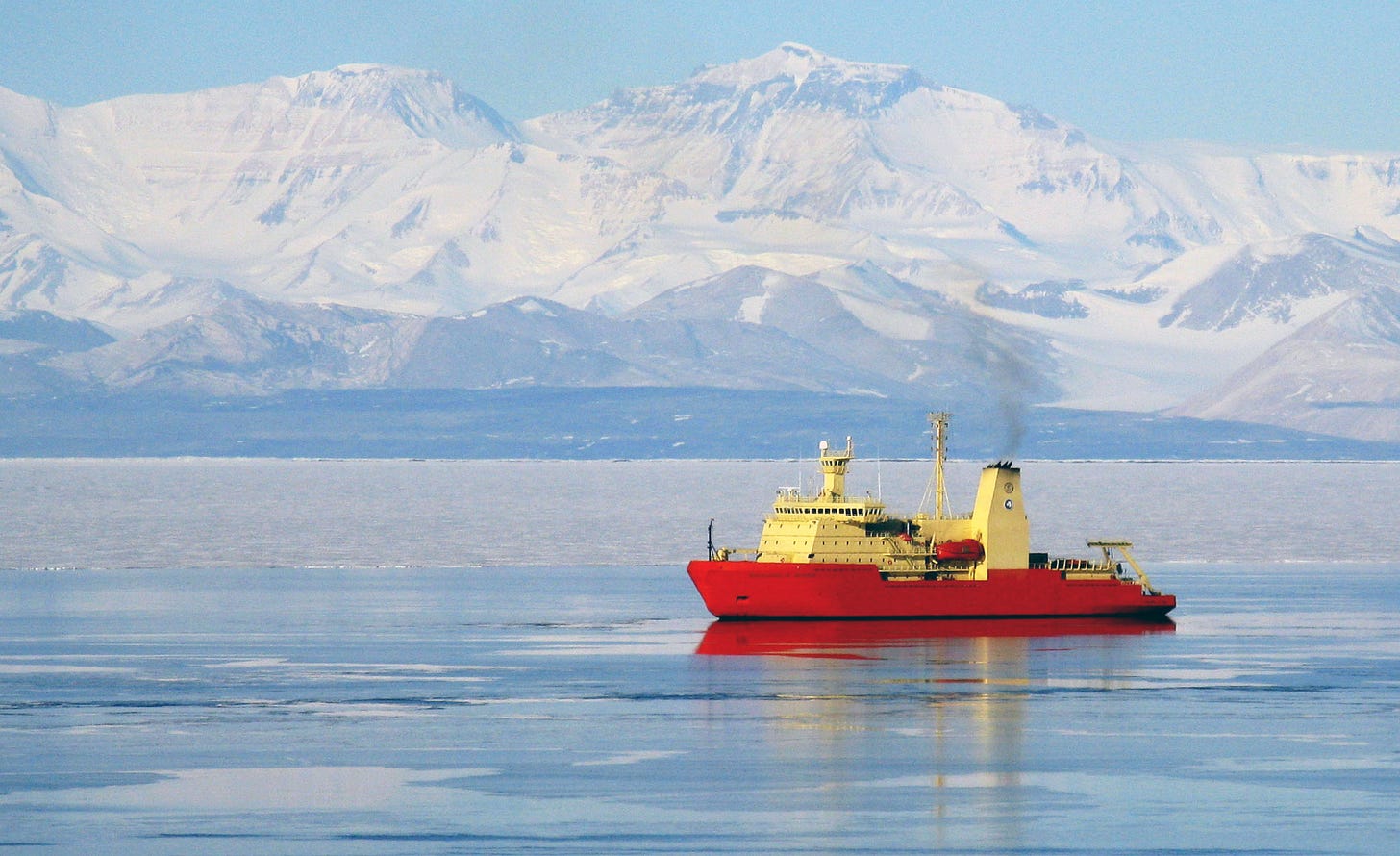For Want of a Ship
8/28/25 - The truth was lost
Hello everyone:
As always, please remember to scroll past the end of the essay to read some curated Anthropocene news.
Now on to this week’s writing:
It can be hard to navigate a world that pulls us in so many directions. The magnets of culture are multi-polar and shapeshifting, whether social, political, technological, or aesthetic. Everything and everyone is busy. And then there’s the subliminal but pervasive cultural message that, for the intensely social apes that we are, pretends to cohere all that chaos: This is how things are. Accept it. How do we find our own bearings if we want to think or go a different way?
One notion I’ve relied on for much of my adult life is a sense of the difference between what is logical and what is rational. “Logical” and “rational” are words whose corners have been worn off by heavy use, but they are distinct enough and important enough that I think it’s worth carrying them around.
There are shelves of philosophy books devoted to these ideas, I’m sure, but as usual I’ll conjure up a few sentences instead.
We’ve been taught via popular media (from Sherlock to Spock) to think of logic as a clarity of thinking, free of emotion. But the most important thing to know about logic is that it is systematic. That is, logical thinking deduces cause and effect by moving from premise and evidence to conclusion, but it does so only within the limits of its system. It occurs purely in the mind, with eyes closed. If my premise is false and my evidence is shaky, my logic will confidently conclude something wrong or absurd. Just ask ChatGPT. Or a white nationalist.
Rational thinking, on the other hand, is more flexible, rooted in judgement, reason, perception, and evidence-based logic in an effort to determine the best possible answer. It occurs in the real world, with eyes open. Of course, attempts at rational thinking can fail because consciousness and culture are complicated, but on the whole it lends itself to sensible and fair conclusions. Rationality, in my simple formulation, is a path to wisdom.
Corporations and other artificial intelligences are logical, more or less, but consumed by a systematic self-interest that nearly always makes them irrational. Their interest is neither social nor human, but they are a reminder, writ large, that everything we as individual humans do or decide has some logic to it. All of our mistakes are rooted in one assumption or another, however conscious or unconscious. We forget that in the kind of logical equations - i.e. If X then Y, X therefore Y - that claim to make sense of the world, “If” is far more important than X or Y.
Science, as a logical system, finds a middle ground by repeatedly testing the premise-evidence-conclusion loop within the real world. Ideally, it recognizes its “If” and keeps its eyes open, refusing to center its conclusions on bias or fear.

This notion has come back to mind this week because I’ve just learned of a small poison pill floating in the vat of undemocratic and anti-science poison known as the recent U.S. federal budget bill. In the inarticulate but calculated fury that they think passes for wisdom, the Trump administration intends to end use of the Nathaniel B. Palmer, the only American icebreaking research vessel working in Antarctic waters, and to cancel plans for the Palmer's replacement, due in the 2030s. It is, on all levels, a bizarre and irrational choice for a government to make. Even geopolitically, as the Times writes, "The decommissioning would leave the United States with no icebreaker to study the southern seas and cede scientific leadership to rival countries like China."
This minor tragedy is a blip in the news landscape, I know, but there’s a story here I can tell that speaks to that landscape in a way you might not hear elsewhere.
The Palmer is quite familiar to me. I never worked aboard, but she came to port in McMurdo several times during my decade on the ice. I’ve known scientists, grad students, and marine techs who, along with her crew, worked extraordinarily long and difficult days, nights, weeks, and months in the quest for data in the most difficult seas on Earth. They sometimes called her the Natty B. She can break meter-thick ice at a speed of 3 knots while carrying 22 crew and up to 45 scientific staff engaged in water sampling, seafloor coring and dredging, piloting aerial drones and underwater ROVs, and much more. The Palmer isn’t the largest or newest or best polar research vessel, certainly, but has been providing a foundation for important and fascinating research since 1992.
As a letter signed by 180 scientists and researchers asking the National Science Foundation and Congress to reconsider the termination of the Palmer’s lease explains,
The United States Antarctic Program has had at least one dedicated research vessel operating in the Southern Ocean since 1968. For those nearly six decades, the N.B. Palmer and its predecessors have supported world-class science that helped grow the U.S.'s standing as a leader of international scientific research. At the same time, these vessels have provided critical logistical support for the U.S. Antarctic scientific bases. Even as automation and remote observations have increased our observational capabilities in this harsh region of the world, there's no replacement for a dedicated research vessel that can access remote sea ice-covered regions of Antarctica and that allows sampling of the full depth of the ocean and coastal regions on land.
The Southern Ocean is vast, largely unknown, and an essential piece of the puzzle that is the future of life on Earth. Its smallest and largest inhabitants - krill and whales - tell the story of how life is faring. Water sampling across thousands of miles and down thousands of feet help us understand how this rarely-visited but deeply interconnected ocean affects our own lives. Measuring changes in the Southern Ocean’s currents tell us how a warming world is disrupting Earth’s fundamental processes. All of this data-gathering can only be done by ship.
More to the point of this essay, perhaps, the impact of climate change on the fate of Antarctic glacial ice will define - is already defining - the fate of global ocean currents and global sea levels. And while research done on the continent is vital to understanding that fate, much of the work must be done by ship. The Palmer, seen in the photo below at the rarely-visited ice front of the incredibly important Thwaites Glacier, has been central to that work. The rapidly-receding Thwaites is the key that may unlock the three meters of sea level rise contained in the West Antarctic ice sheet, and we need ships to, among other tasks, send ROVs under the ice front to map the unseen.

So what might be the Trump administration’s motivation in eliminating American science in the Southern Ocean? I’m not sure, but the answer seems to be some combination of malevolence and neglect. Here are my two general thoughts:
Fossil fuel lobbying: The Palmer, a key platform for Antarctic research into the impacts of climate change, might be the victim of the Trump administration's quid pro quo with the fossil fuel industry. As I’m sure you’ve noticed… in exchange for Trump’s request for a billion dollar payment from the industry to the campaign, the U.S. government is now actively erasing as much climate-related regulation and research as possible.
Authoritarian power: The administration seems to be working furiously to create an fascist state whose sole source of power (and “truth”) would be the executive branch, with Congress and the courts fully weakened or complicit. The logic of this executive branch is largely informed by misogyny, white nationalism, and Christian fundamentalism, with its architects fed on delusions about the certainty of “race,” gender, and religion. Cutting funding indiscriminately to scientific programs and institutions makes sense because it weakens the very idea of evidence-based decision making. Science, indeed the very idea of the scientific method, undermines fundamentalism, exposes biases, and poses a threat to centralized power.
In a recent
column, she quotes William Burns, former CIA director, about why the Trump administration is gutting public service institutions of staff, funds, and leadership:It is about breaking people and breaking institutions by sowing fear and mistrust throughout our government. It is about paralyzing public servants—making them apprehensive about what they say, how it might be interpreted, and who might report on them. It is about deterring anyone from daring to speak truth to power.
On the subject of speaking truth, in
’s slim but essential book, On Tyranny: Twenty Lessons from the Twentieth Century, he writes in Lesson #10 (Believe in truth) thatTo abandon facts is to abandon freedom. If nothing is true, then no one can criticize power, because there is no basis upon which to do so. If nothing is true, then all is spectacle. The biggest wallet pays for the most blinding lights.
The logic of tyranny is an irrational force. Its limitations become more obvious the more that force is applied. It can only feed on what it claims is true (racism, misogyny, two-dimensional faith) and like a corporation it can only act on its single-minded goals (power, profit, control). There is good news in this, as those limitations become weaknesses in a world working to reclaim power for the people.
As the great Tom Waits sings, “The higher that the monkey can climb / the more he shows his tail.” That’s from “Misery is the River of the World” (audio here). If you’re new to Waits, the song will sound like the dark utterances of a circus barker rowing your soul across the river Styx, but he is throughout his work a master songwriter of lines that blend despair and love, character and consequence, humor and pathos. I’ve been listening to a lot of his songs recently, and was moved to title this essay “For Want of a Ship” because of some other lines in the song:
For want of a bird The sky was lost

I’ll retreat now from the irrational monkeys and return to the world you and I inhabit. In it, “the antidote to despair is imagination,” as the prescient Octavia Butler reminded us. In it, an incredible array of good and rational work is being done to temper the fascist impulse, study and protect the living world, and to tell the stories than enable all of the above. As always, check out my collection of weekly news items below for some of those stories, and dig through my recommended Substacks (on my home page) for great nature writing and other upbeat Anthropocene news.
I’ll close with a little self-reflection. Who am I, as just another irrational and biased ape, to define what is rational? And what might you or I claim as a universally agreed rational framework? What we consider common sense, quite often, is often riddled with subjective biases and cultural oddities (like calling a ship named for a man “she”).
There are some universal foundations to cling to, certainly: The ephemeral certainties of music, for one, or the silent music of the spheres we call mathematics. But we need a foundation that articulates itself with words as well as numbers and notes. And that leads us, often, to the patiently growing fields of science, where data and debate produce and refine truths about our short lives in this eternal world.
But as I’ve often noted here, while science is as vital as rain for ensuring a survivable Anthropocene future, it is still as unnatural to the human ape as democracy. The edifice of knowledge is built by people as quirky as you and me. Science is an achievement, not an instinct.
So perhaps we might include within our assessment of what is rational with an ecological query, i.e. whether our decisions - individually or at societal scale - are beneficial to life. Science informs this judgement, certainly, but despite our digitized and boxed-in lives we all still readily discern a living landscape from a death zone. We can distinguish a butterfly from a backhoe. We all know on some level whether what we’re doing is good for our children’s children. Or, if not, given an opportunity we’re willing to slow things down to ask good questions.
The question for today, then, is what possible benefit for future generations and the world they’ll inhabit could come from ending the Palmer contract and cancelling plans for a next-generation icebreaking Antarctic research vessel? We need more research, more data, and more stories of how the planet is changing and what we can do to limit the damage.
To that end, I have some stories for you that I think you’ll enjoy, all of which are based on work done aboard the Nathaniel B. Palmer:
First, for a sense of how intense work and life can be while aboard the Palmer during its research expeditions, I recommend this Eos article, “Confined at Sea at the End of the World.”
Second, I suggest you read a book that’s been on my list for a while: The Quickening, by Elizabeth Rush. The Quickening is a nonfiction account of a research expedition to the Thwaites Glacier, and a meditation on what Antarctica and its mysteries tells us about how to live in a disrupted world. Here’s the LA Times review.
And finally, for a mesmerizing glimpse of the work done by the Palmer as an icebreaking research vessel in Antarctic waters, check out this five minute video from 2013 by Cassandra Brooks, then a doctoral student, now an environmental scientist. Her early work helped drive the creation of the world’s largest marine protected area in Antarctica’s Ross Sea, and she knows how to tell a visual story.
Such good work is a reminder of the intimate links between the rational, the ecological, and the beautiful.
Thanks for sticking with me.
In other Anthropocene news:
From
and The Crucial Years, a rational proposal: A massive global effort by governments and billionaire philanthropy to flood the world with cheap (or free!) solar panels.In very related news, a reminder of the upcoming Sun Day, happening on the equinox, September 21st. Sun Day is a national day of action “to celebrate the power of clean energy.” There is a metaphor to be made, amid our unrest against a fossil-fueled would-be authoritarian state, in celebrating decentralized solar power. Find (or create) an event where you live. As the organizers explain,
By organizing thousands of events on the fall Equinox, Sun Day will help accelerate the ongoing clean energy revolution: we have the technology and the solutions, all we need is to build the political will to scale-up and accelerate clean energy and make it accessible to all.
From Grist, some rational thinking about the seemingly irrational prospect of altering ocean chemistry to help cope with the Earth’s man-made CO2 problem. It’s the kind of engineering that should never be done but which might be necessary on a planet that we’re already blindly geoengineering every day.
From Politico, hopeful news of large-scale environmental progress in Europe because a solution to the threat of a possible Russian land invasion is also a solution to greenhouse gas emissions: repairing and re-flooding vast amounts of peatland along the border. The more eastern Europe revitalizes its peatlands, the less CO2 escapes the massive carbon sinks, and the more impenetrable boggy territory the countries gain ahead of any possible invasion by tanks. Here’s the kind of discussion that’s happening in Poland:
“What the ministry of defense wants is to get back as many wetlands as possible along the eastern border,” Kotowski added. “And that is what is required from the point of view of nature restoration and climate as well.”
Cezary Tomczyk, a state secretary at Poland’s defense ministry, agreed. “Our objectives align,” he said. “For us, nature is an ally, and we want to use it.”
From the Guardian, a new study finds that wolf hunting in Montana and Idaho has not had a significant impact on livestock predation, the problem it’s meant to solve. Data show, for example, that on average it takes the slaughter of 14 wolves to save a single cow. The situation is more complex than that one statistic shows, of course, but it does suggest quite firmly that wolf hunting is not an effective deterrent.
From
and Nature Briefs, an explanation of how seed dispersers - from birds to monkeys and fish - are vital to the health and survival of forests, and how these species are disappearing. “For millennia, this simple, intimate cycle has been the unseen engine of the world’s forests,” Butler writes, “But now, that cycle is breaking down.” Butler is the founder of Mongabay, one of the best (and most vital) media companies reporting on environmental news. I’ve subscribed to Nature Briefs, and I recommend it. (Thanks to for bringing Butler’s work to my attention.)From Mongabay, an interview with author Alan Weisman about his new book, Hope Dies Last, which chronicles Weisman’s journey around the world talking with unheralded folks doing great work to repair our relationship with the living world. Here’s the interviewer’s pitch:
I bought Alan Weisman’s Hope Dies Last in a bookstore despite knowing nothing about it and based purely on the title. Four hundred pages later, I sat down with the author to talk about the miraculous accomplishments and resilience of the book’s protagonists, many of whom are working to solve humanity’s most intractable ecological problems.
From
and Conservation Works, “Our (Not Quite) Domesticated Planet,” some wisdom on what “domestication” means in a world shaped by human behavior, and other thoughtful observations on conservation news from around the world. As always, Michelle’s writing is well worth your time.



I have a modest proposal for one way to observe Sun Day on this coming Fall Equinox, and that is to observe an Energy Sabbath.
For that day, turn off our phones, park our cars, don’t turn on any switches, appliances, power tools, or electronic devices. For one day give ourselves and nature a rest from the constant demands of human energy consumption.
And if we go on and observed this sabbath on every Sunday we’d immediately reduce our contribution to the climate crisis by 15%. And best of all we would increase our peace, our mindfulness and our sanity beyond measure.
I believe this baby step would have a cascading effect, and in time would lead us back to Eden. It seemed to be an essential part of our creation in the beginning, and might be a wise choice for a return to balance.
“The Southern Ocean is vast, largely unknown, and an essential piece of the puzzle that is the future of life on Earth.”
Of course those of us who know how to read, and do, understand that none of these ‘deleted’ research studies have anything to do with saving money.
“Measuring changes in the Southern Ocean’s currents tell us how a warming world is disrupting Earth’s fundamental processes”
And there it is, if the research is not there to lend credence to a “warming world” then there would be no need to spend time discussing and disproving . It all points back to enabling private corporations to do what ever they please without being regulated, cutting corners when it comes to protecting the environment, the bottom line, above all, money and greed. Which goes right along with the only things that Trump has accomplished, for himself of course, retribution and greed. As I read and write ,usually at the same time I am reading a post, we both came to the same conclusion, lobbyists have already been paid a ‘ship load’ of money to the administration (Trump personally, through his ‘library fund’? Who the F knows) to make sure things go their way. And everything else you mentioned here.
Thank you for the education, Jason . The Nathaniel B. Palmer, detrimental research quietly defunded , but to decommission the entire ship, without so much as a whisper in the press, is disgusting. Just when I think things can’t get any worse under this administration, they inevitably do, seems like daily. Well, not seems like it, it actually does.
P.S. I read Heather Cox Richardson every day, along with Jeff Tiedrich, just to take a tablespoon of laughter to go along with the latest malady.